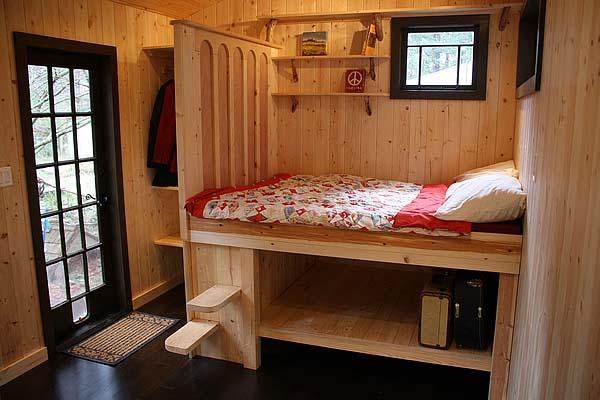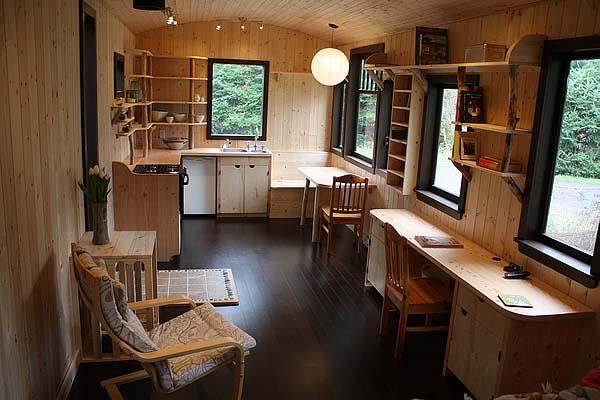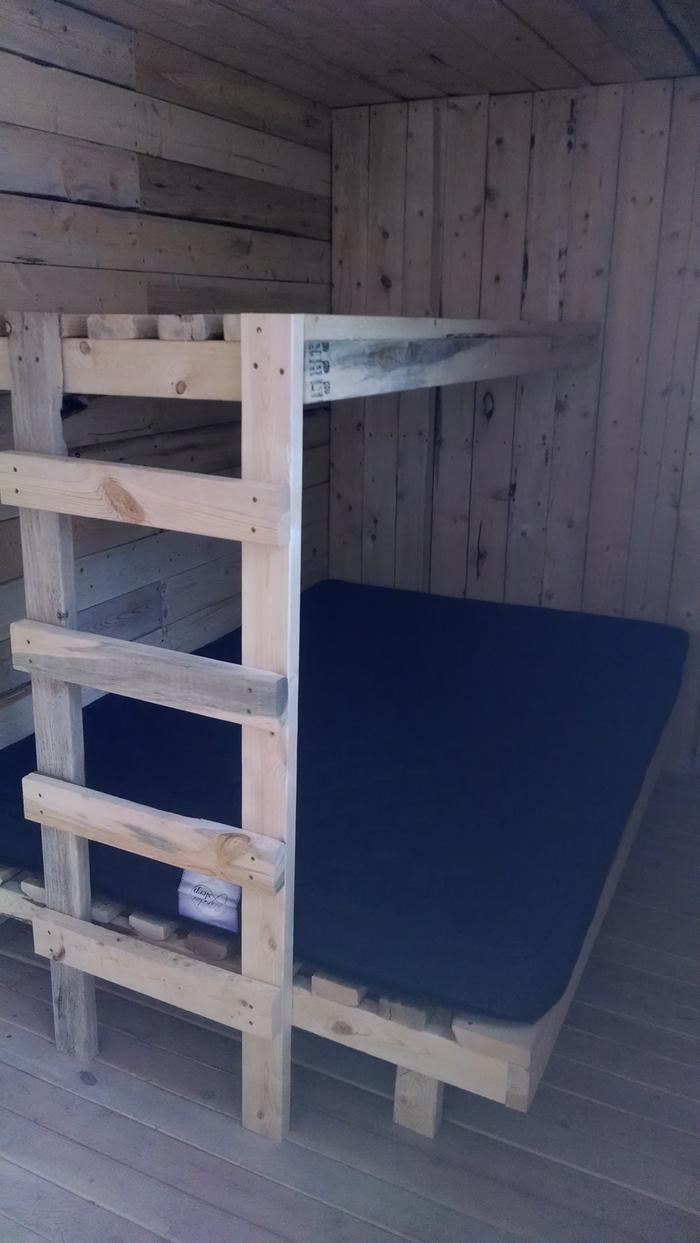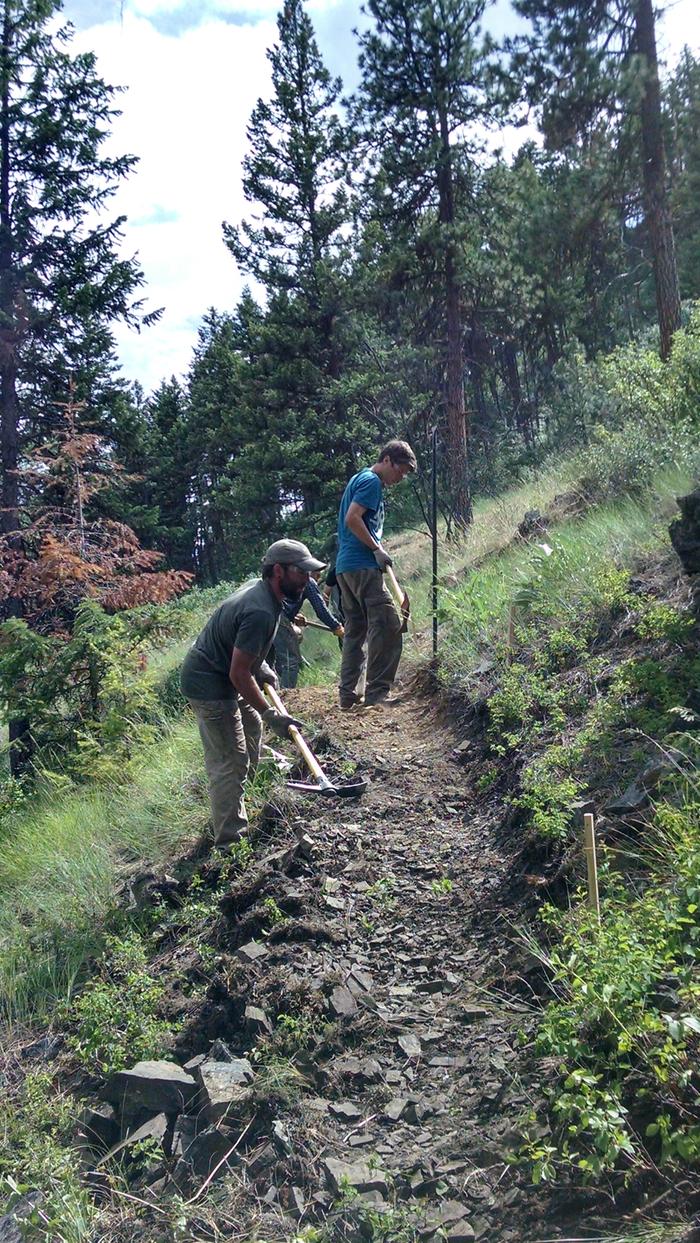posted 11 years ago
A few thoughts
- Regarding the original diagram:
- Clearances to combustibles seem a little tight; I would allow more space especially around the barrel.
- Are the upward-pointing T's for cleanouts? I would locate them closer to the ends of the bench; it's easy to reach down a long pipe from a corner cleanout, hard to manipulate obstructions at corners from a long pipe away.
The most important place to access with a cleanout is the manifold under the barrel, followed by the exit chimney, then the 180-degree bend.
- I agree about including insulation on floor and walls of this structure, especially if the undercarriage may remain exposed to cross-breezes. Trying to heat the current, slab-walled structure will result in a heater that is massive overkill once the insulation is in place.
- For general portable housing, I agree that good insulation is a better investment than thermal mass heating - for the general case.
Mass = heavy loads to transport, whereas insulation is usually very lightweight, and allows you to cut heating loads by large factors.
(e.g. R-30 insulation compared with an R-5 non-insulated wall means 1/6 the heating load, but usually only a few % more weight - maybe 10 to 100 lbs for a 500-1000 lb trailer structure).
Similarly, our ancestors used canopy beds, cupboard beds, down and woolen insulative comforters and clothing to reduce the indoor temperatures needed for health and comfort. Any reduction in comfortable indoor temperatures reduces heating loads by quite a lot.
For a cabin of this size, a cupboard-bed in one end with double insulation might prove easier to keep warm overnight than the best stove setup.
I will assume that we are designing for a technically 'portable' shelter, but one which may be occupied in extreme cold for long enough, or often enough, to make efficient heating worth the investment.
Issues with INSULATION:
- Withstand vibration & warping effects of travel (insulation boards or batts rather than loose-fill which may settle badly; fiber-based wall coverings like wood panelling or fabric, rather than brittle materials like cement stucco or plasters.)
- Maintain minimum air flow for interior habitability: about 1/3 of the buildings air volume per hour. Campers without good ventilation are subject to major mold problems.
- Manage vapor-barriers, if used, so that both indoor and outdoor humidity cannot cause condensation problems within walls.
Campers will experience more different climates than stationary homes, and more fluctuations of indoor humidity due to sporadic occupation.
(Condensation happens when moisture or moist warm air meets a cold, impermeable surface. Dew forms on the cold surface and runs downward into whatever pockets. Wall fittings such as electrical outlets, where insulation is thin, can be bad spots for encouraging condensation. Solutions include using permeable or fibrous materials instead of non-permeable vapor barriers, to breathe and wick away water (wood, cloth, or leather instead of vinyl); never placing double vapor barriers on two sides the same wall; and trying to separate any cold surfaces from air flow using insulative non-permeable materials, such as closed-cell pour foam.)
- Since I'm going into difficulties in detail below, worth noting that ALL mass-heater channels that are not double-lined with permanent masonry must be VERY CAREFULLY sealed, and should be monitored for CO or smoke leaks.
Portable mass heaters will endure road vibration, extreme "settling", and other forces not normally considered in the design of masonry-heater-type appliances.
- Regarding removable mass for transport:
WATER MASS:
Water is attractive for its thermal capacity and general availability at most campsites (we don't stay anywhere long without it), but all the problems mentioned above are real. To summarize:
- Steam evaporation (cooling, plus indoor moisture / mold potential);
- boiling (the above plus explosive potential). Explosion hazard increases with any system that depends on full tanks, pumps, thermosiphons, or monitoring devices to prevent overheating; redundant safety measures are essential.
- freezing (expansion and damage to tanks / pipes / fittings);
- disease (many diseases thrive in stagnant water. Legionella is an unusual bacteria that thrives in warmer-than-lukewarm water, and causes disease through aspiration (breathing it in the shower); when the water is not sprayed, the legionella rarely causes health problems. There are all manner of other bacteria and microbes that will breed at almost any temperature right up to boiling; not all germs cause disease, but even the innocent ones can cause weird odors and gluck buildup.).
- strain, load, and balance issues if the structure is ever hauled with full tanks, or if tanks are imbalanced during hauling.
Other dangers not mentioned include
- scalding (water/ surfaces over 120 F, any splashing during transport if people are inside; and especially scalding and hot moisture buildup around steam leaks);
- corrosion (non-pressurized systems that are less likely to explode, are more likely to contain oxygen that can accelerate both corrosion and "gluck" buildup from aquatic life);
- likelihood of leaks and damage from road vibration and debris, structural flexing, and so on.
- Scale buildup is a problem for most plumbing, but may be more so in a heated and cooled tank using non-potable water.
- Overheating: Water tanks imply a variable thermal mass, and therefore variable load on the heater. Any heater that uses water as a thermal mass should be configured to operate safely when empty, as well.
Let's be very clear, that no matter what kind of water is put into a mass-heater system, the result will be non-potable water under all likely conditions of use and maintenance.
All of the above are problems that can be dealt with, quite successfully by modern engineering. Indeed, warm water was a resource used successfully by our ancestors in cooking, washing, and geothermal baths.
But they make using water as thermal mass a sight more complicated than insulation. Water is a very dense material, with great heat capacity (anything better, like solid metals, tends to be far more costly). Plus it's non-toxic, non-polluting for discharge (the occasional ice or rust patch notwithstanding), and available at all suitable campsites.
The simplest and most easily-maintained method might involve separate, liftable water units like pots, buckets, or old-fashioned milk jugs, with a cookpot-type lid (loose enough to vent steam, but tight enough to prevent undue evaporative loss). This has been used to their satisfaction by woodstove owners elsewhere on these forums.
Whether the containers should be metal or plastic depends on the temperatures involved, and whether corrosion, vibration, or heat is the limiting factor for container lifespan. To limit carrying distance, one container or a drainage pan under the whole thing (to catch leaks and splashes) could be hooked up to an exterior drain tap.
If you have the skills to cushion your plumbing from all of the problems mentioned above, then one or two tanks with an outside drain might also be practical.
MINERAL / OTHER MASS:
- Other removable mass options: dirt, sand, rocks, gravel. Essentially, any mineral mass you may find on site, and which can be reasonably expected at future sites. More suitable for long-term occupancy of a site, with rare and relatively slow towing. Not super-likely to be on hand at trailer parks, but if you are moving to any site permanent enough to consider trenching in some water pipes or electrical, loose dirt is likely to be available.
Difficulties include
- the possibility of introducing soil biota that want to eat your structure (ants, termites, fungi), or other undesirable contamination (soils that offgass something when heated?); and of transporting the same between sites.
- a somewhat messy loading and unloading process, which undeniably involves "work"
- reduced thermal storage effectiveness (compared with solid or water mass) due to thermal mass being lower, and conduction reduced in favor of insulation effects of air pockets in any granular mass.
If you are planning to re-use the same gravel in a new location, the benefits of being able to remove it for travel are negligible, as it's the energy required to transport that mass that is a problem in the first place. If you are planning on hauling the whole load around anyway, consider upgrading to a smaller amount of dense materials such as masonry, clay or ceramics, or water units.
- Regarding a rocket as overpowered for a particular space:
6" rocket heaters are routinely used in spaces under 100 square feet. The "rocket" part of the name does not imply any special excess of fuel, but rather a tendency to burn clean with good draft and a "whooshing" sound.
Regarding 4" and smaller rocket heaters: Cookstoves are commonly (and relatively successfully) made to this size; we've worked with 3" and 4" cookstoves that put out huge amounts of heat for hours at a time.
A 4" J-tube heater core can be used to power a radiant heating firebox; and potentially for short, mostly-vertical runs of heat-exchange pipes. The problems we've seen come from trying to extend the length of 4" pipe to heat a similar thermal mass to a 6" or 8" system, without realizing that the extra surface area and reduced diameter of the 4" pipes creates a LOT more drag on the system. Most 4" heaters don't have enough "push" to overcome much length of drag, so the heater works more like a woodstove (quick-response radiant heat) than a masonry stove or mass heater.
There are small masonry stoves and soapstone stoves that also split the difference, giving clean-ish fire and long-ish heat storage compared with small woodstoves.
- Regarding the heat of cooking as sufficient to warm a well-insulated space:
Absolutely. If the cabin is a sleepout associated with a central camp kitchen, then a good insulated sleeping area / bed, and a heat-giving lamp such as kerosene, or electrical (incandescent or IR lamp), could be more than sufficient.
If the cabin is stand-alone quarters for someone wintering over, perhaps as a site caretaker in a remote corner of a property, or as a getaway cabin for an owner who is still working in the city to pay off a new land purchase, then cooking and/or heating facilities might be important.
A rocket heater's barrel doubles as a reasonable cookstove / coffee stove, and can be fitted with an oven or stockpot on top (stockpot full of water = thermal storage, plus normal washing and cooking functions).
A small cookstove might also do the job, but without the benefit of overnight heat from (non-burning) mass.
Regarding fire danger:
Burning a woodstove or cookstove all night, or a rocket heater during the day - I think the fire danger would be greater with the woodstove, assuming the rocket heater was constructed with reasonable care.
There are safer, virtually fireproof space heaters, but the ones I know rely on fossil fuels or on-grid power that may not always be accessible in the camping locations that a mini-house adventurer might enjoy.
- I assume that a portable dwelling would be occupied only at rest, and that we do not need to heat it while in motion, nor protect occupants from the dangers of motion + heat e.g. scalding water splashing about.
If there is any intention to have people live in it while underway (as in many types of boat), then I'd look into boat-type heaters and good insulation.
Boats often use a small diesel or propane space-heater, to reduce hazards from tipping or shifting during travel. Cookstoves may be diesel, wood, or gas fired; for most cruisers and fishing boats, the cookstoves (and many lamps) are mounted on gimbals. Electrical heaters are not typically used except on luxury boats, as the electricity has to be generated or collected from solar on board, and heat takes a lot of energy. If you're going to run a diesel generator to power your heaters, you might as well run a diesel heater with fewer losses. If your boat is going to depend on dockside power for successful cooking, it's basically a dock not a boat.
All of these marine solutions tend to be more expensive than a comparable heat-output device for stationary dwellings. They may use stainless steel (corrosion resistant), specialized exhaust protection from waves, and other features that a camper doesn't need. But they're worth investigating for inspiration.
That's my thoughts so far.
-Erica













 6
6









 4
4













 1
1






















